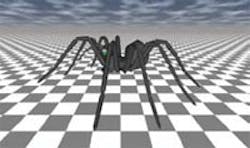Boris, Delcam’s spider logo, is not just a marketing or branding gimmick.
It played a role in developing Delcam’s first multi-surface machining algorithms that used a technique called Z-buffering, and it laid the foundation for Delcam’s flagship CAM product, PowerMILL.
How the spider came to be often has been the center of speculation, and Delcam offered the following story and a glimpse into the very human side of CAM software development: In 1984 Jon Hunwick joined Delcam as a technician.
Today, Hunwick is a support engineer for the company’s PowerSHAPE software, but in the early days his responsibilities included making sure the company’s PRIME 250 computer started every morning and that reel-to-reel back up tapes were made.
At about the same time, Gavin Miller joined the unit as a post-graduate student working on advanced raytracing. A massive Sigma frame-store was brought into the department for Miller to use, but it required huge amounts of processing power, so Miller found himself working overnight most of the time so he did not have to share computer time with the PRIME 250.
Besides producing interesting ‘mechanical’ effects, such as lighting, shadows, and reflections, Miller was interested in natural phenomena, such as rippling water, fractal landscapes and hair.
After he was able to create the effect of fuzzy dice successfully, Miller looked for a more interesting challenge.
That challenge came to him one night at about 2:30 a.m. when a large – and exceptionally hairy – spider fell from the ceiling, landed on his keyboard, then nonchalantly lowered itself to the floor. As it progressed across the floor, it grew bigger in Miller’s mind until, to his imagination at least, it appeared the size of a small dog.
Next morning, when Hunwick arrived, Miller said he wanted Hunwick to make a spider in DUCT, the original Delcam product that PowerMILL spun from.
Hunwick took the individual pieces, traced them onto graph paper and, over the next days, transferred the coordinates into DUCT. As he did so, Boris took shape.
Miller then set to work and produced images.
Not satisfied with simply being able to create fancy pictures, another part of Miller’s work was to create DUCT’s first multi-surface machining algorithms, using a technique called Z-buffering.
Hunwick worked out how to machine and assemble the spider, and the finished model was cut on a Bridgeport Series 1 CNC milling machine.
The finished Boris looked like this:
A month later, Hunwick took the metal Boris to an exhibition in London. Hugh Humphreys, managing director of Delcam, visited the show for a day, saw the spider and decided to take him back to Birmingham to become the company mascot.
Since then, Boris has become the official Delcam logo, and hundreds of metal versions, in differing scales, have been produced. He has also been seen in STL format.
The only question remains is where the name ‘Boris’ came from?
The answer is simple, about the same time that Boris was created, the rock band “The Who” had a song called “Boris the Spider,” and the name stuck to Delcam’s mascot.
